Moon Doings on Mid-Summer Evenings, Planets Party from Dusk to Dawn, and Meteors, in Moderation!
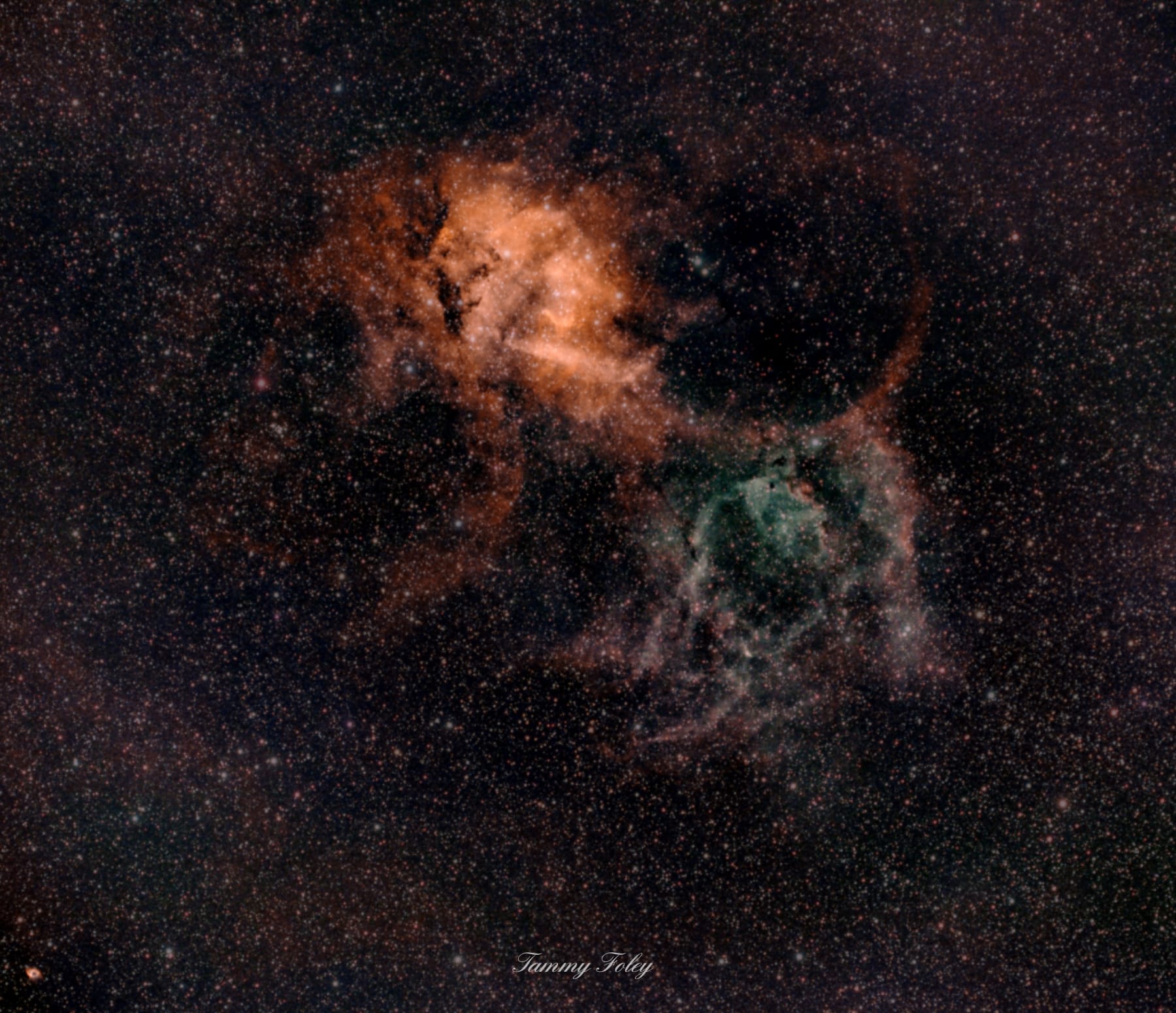
This fantastic image of the Lion Nebula, also known as Sharpless-132, was imaged and processed by Tammy Foley. She gathered 19 hours of exposure time through various filters for it. During evening in early August, the lion is prowling the northeastern sky between the W of Cassiopeia and the bright star Deneb in Cygnus, but it’s best observed in autumn, when it’s highest. The north-up image covers about a thumb’s width of sky! The lion’s head is composed of glowing ionized hydrogen. The body is a mixture of glowing hydrogen filaments, plus the bluish light of the double star MLP 611 scattering off of surrounding dust and non-ionized gas.
Hello, Mid-Summer Stargazers!
Here are your Astronomy Skylights for the week of July 31st, 2022 by Chris Vaughan. Feel free to pass this along to your friends and send me your comments, questions, and suggested topics. You can also follow me on Twitter as @astrogeoguy! Unless otherwise noted, all times are expressed in Eastern Time. To subscribe to these emails please click this MailChimp link.
If you’d like me to bring my Digital Starlab portable inflatable planetarium to your school or other daytime or evening event, or deliver a session online, contact me through AstroGeo.ca, and we’ll tour the Universe, or the Earth’s interior, together! My terrific new book with John A. Read entitled 110 Things to See With a Telescope is a guide to viewing the deep sky objects in the Messier List – for both beginners and seasoned astronomers. DM me to order a signed copy!
The moon will shine in evening skies worldwide as it waxes through first quarter, showing a Lunar X in daylight, passing a number of bright stars and occulting others. Mercury’s addition to the western sky after sunset makes all the planets observable from sunset to sunrise. Sunday brings mid-summer and the lengthening of summer nights for northerners. Read on for your Skylights!
Mid-Summer
The daylight hours are shortening at a faster rate now for mid-northern stargazers. Over the course of this week, we’ll swap almost 17 minutes of daylight for night. That pace will increase until the first day of autumn.
Sunday, August 7 at 8:36 am EDT (or 12:36 GMT) will mark the mid-point of summer in 2022 – falling halfway between the June Solstice and the September Equinox. It is one of the four so-called cross-quarter days, which are the season midpoints following each solstice and equinox. Many pagan groups schedule Lammas or Lughasadh festivals around this time – to celebrate the early harvest. The term “lammas” refers to grain or bread. (Tolkien readers will notice that it resembles the word “lembas”, the Elven Waybread, from the same root.) The next cross-quarter day will occur in three months, at the beginning of November. That’s Samhain – but we celebrate it on the evening before – as Halloween!
The Earth reaches it farthest distance from the sun, or aphelion, in early July each year. Since Kepler’s Laws of Planetary Motion dictate that a planet moves slowest while at aphelion, summer in the Northern Hemisphere is several days longer than winter! Enjoy!
Meteor Shower Update
The Southern Delta Aquariids meteor shower peaked overnight on Friday-Saturday, July 29-30, but it will continue to taper off for another week or so, allowing you to keep an eye to the sky for shooting stars. The much more prolific Perseids meteor shower, which runs annually between July 17 and August 26, has begun, too! That shower will peak on August 12, albeit on a full moon night.
Moon-doings
This will be the week of the lunar month when our planet’s partner is perfectly positioned for perusing post-sunset. Tonight (Sunday) the young crescent moon will be visible above the western horizon for a short time after sunset. Watch for stars of Leo (the Lion) appearing around the moon just before the moon sets in a darkening sky – especially bright, white Denebola, which will twinkle a fist’s diameter above (or 10° to the celestial northeast of) the moon.
For the rest of this week the moon will swing steadily farther from the sun, causing it to wax in illuminated phase and to set 20 minutes later each night. Normally the interval between moonsets increases by about 50 minutes per day. But the ecliptic and the moon’s orbit are both so slanted on late July-early August evenings that the moon’s daily change in position is mostly right-to-left instead of higher.
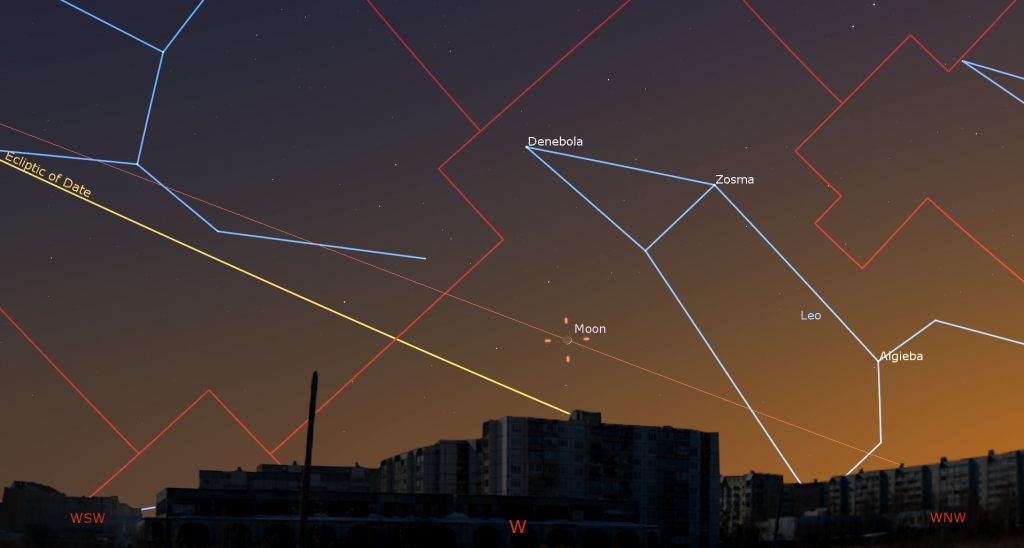
The moon will spend Monday to Thursday sliding along Virgo’s lengthy form. If you have a small telescope, point it at the bright star shining to the moon’s upper right on Tuesday night. That’s the terrific double star named Porrima, also known as Gamma Virginis. Under magnification it splits into a matched pair of yellow-white stars, like distant headlights! Observers in the Maritimes will see the moon somewhat closer to the star after dusk. Due to the moon’s orbital motion, the farther west you live, the farther east of the star the moon will be.
On Wednesday, the moon will be shining a few finger widths above Virgo’s brightest star Spica. Because it shines near the ecliptic, the moon can pass in front of, or occult, Spica, from time to time. The other bright stars the moon can occult are Aldebaran in Taurus (the Bull), Antares in Scorpius, and Regulus in Leo (the Lion).
Dust off your telescope or binoculars and look at the moon this week! Sunlight arriving along the terminator boundary that separates the lit and unlit hemispheres is nearly horizontal, so it throws the lunar terrain along it into stark relief. The terminator creeps across the lunar surface night-by-night and even hour-by-hour, highlighting new zones as it goes. On Thursday night, part of the curved mountain ranges ringing the right-hand (eastern) rim of huge Mare Imbrium will be dramatically illuminated. The following two nights will reveal more of them, as well as the giant, basalt-filled basin they surround.
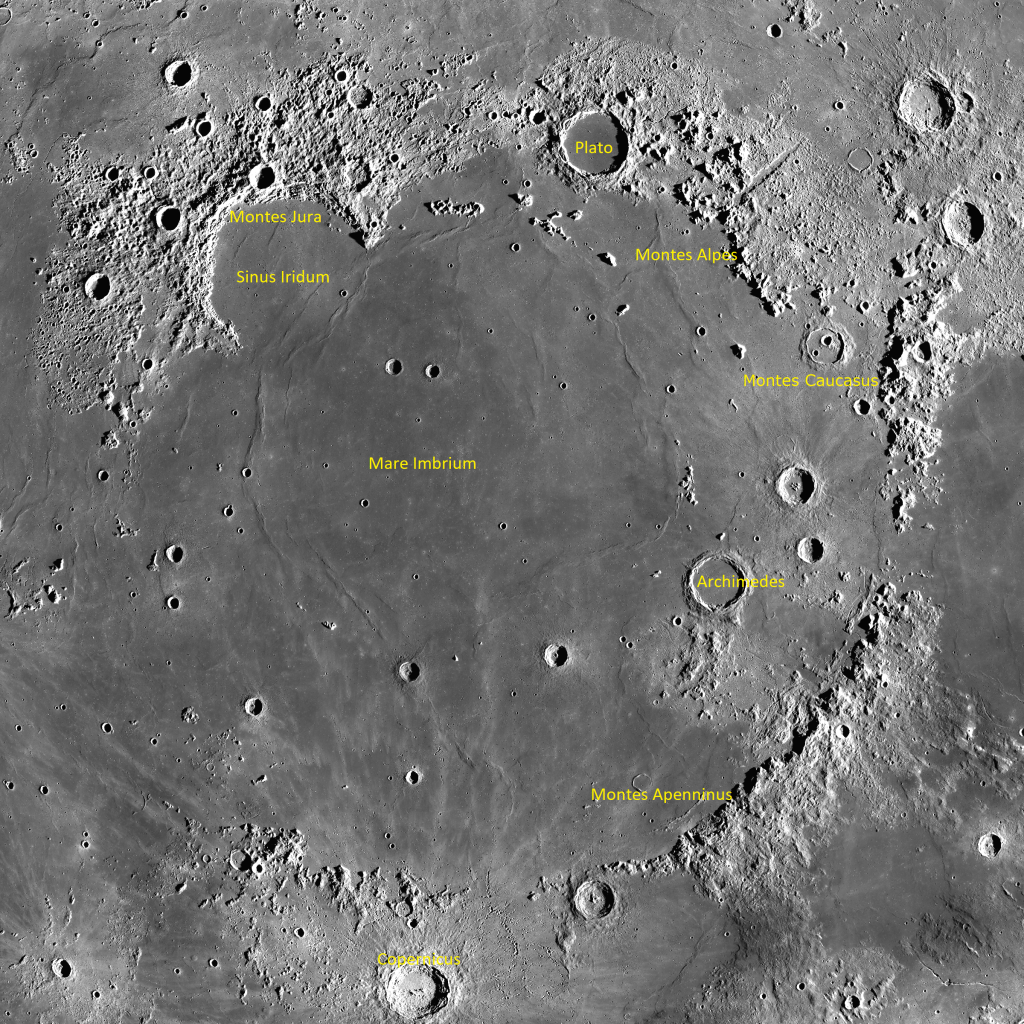
At this phase of the lunar month, the moon is rising during the afternoon. On Thursday in the Americas, the Lunar X and Lunar V features will form on the moon for about 3 hours – between 4 pm and 7 pm Eastern time. The bright X-shaped pattern appears when the rims of the craters Purbach, la Caille, and Blanchinus are illuminated from a particular angle of sunlight. Look for it beside the terminator, about one third of the way up from the southern pole of the Moon. The Lunar V forms along the northern span of the terminator near the crater Ukert. Viewing the moon through polarized glasses in daytime will increase the image contrast. Observers in Europe and western Africa can see the phenomena while the moon shines in a dark sky between 20:00 and 23:00 Greenwich Mean Time.
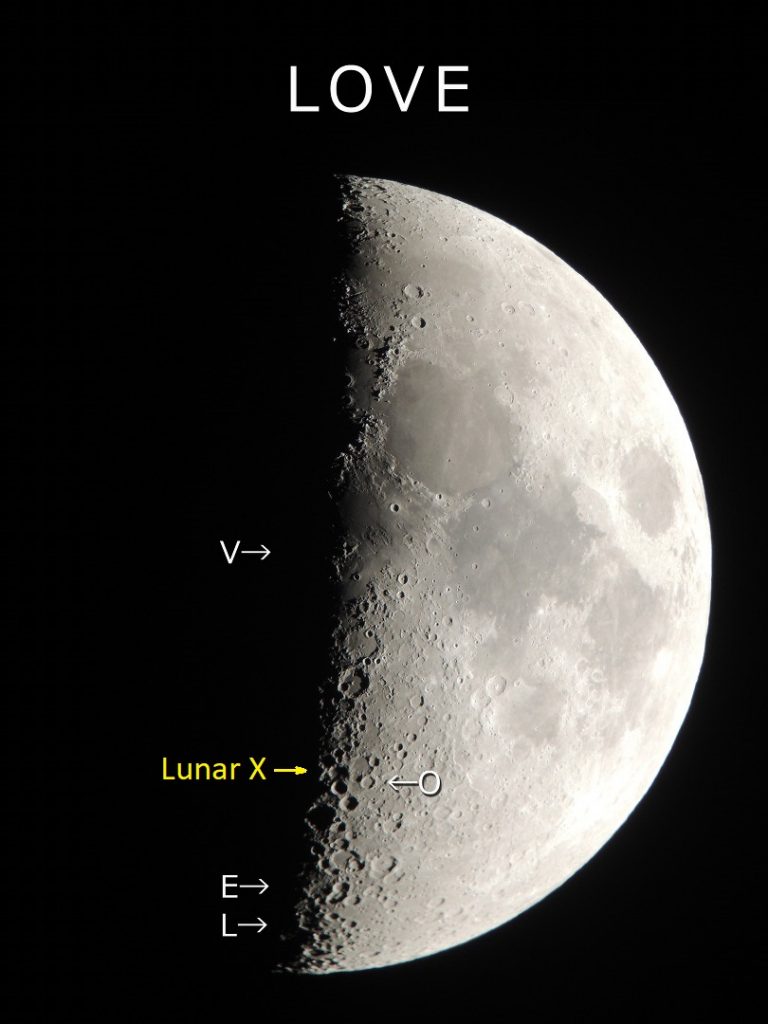
The moon will officially reach its first quarter phase, appearing half-illuminated on its eastern, sunward side, on Friday at 7:07 am EDT or 4:07 am PDT and 11:07 GMT. At that phase, the lunar terminator temporarily becomes a straight line, which told ancient astronomers that the moon was a sphere. By the time that the moon shines during evening in the Americas, it will already be slightly gibbous (i.e., more than 50%-full). The stars of Libra (the Scales) will surround it.
In the southern sky after dusk on Saturday night, the waxing gibbous moon will shine in western Scorpius, between that constellation’s brightest star, reddish Antares, and the up-down row of small white stars that form the scorpion’s claws, namely Jabbah or Nu Scorpii, Graffias or Acrab, Dschubba, Pi Scorpii, and Rho Scorpii. A backyard telescope at high magnification will reveal that Nu Scorpii, Acrab, and Dschubba are close-together double stars. Turn the telescope to the moon to see the big crater Copernicus alongside the terminator near the moon’s equator.
The bright moon will end the week among the stars of southern Ophiuchus (the Serpent-Bearer), spoiling our views of the nearby summer Milky Way. Observers with backyard telescopes in eastern North America and Central America can watch the moon occult the close-together double star Guniibuu also known as 36 Ophiuchi on Sunday evening. Times vary by latitude. For the Great Lakes region, the dark leading limb of the moon will cover the two stars at 10:34 pm EDT. They should wink out about 7 seconds apart. They’ll reappear from behind the moon’s opposite bright limb at 11:48 pm. Start watching a few minutes ahead of those times. The moon will also pass in front of several other nearby stars, including a more widely separated double star 38 Ophiuchi.
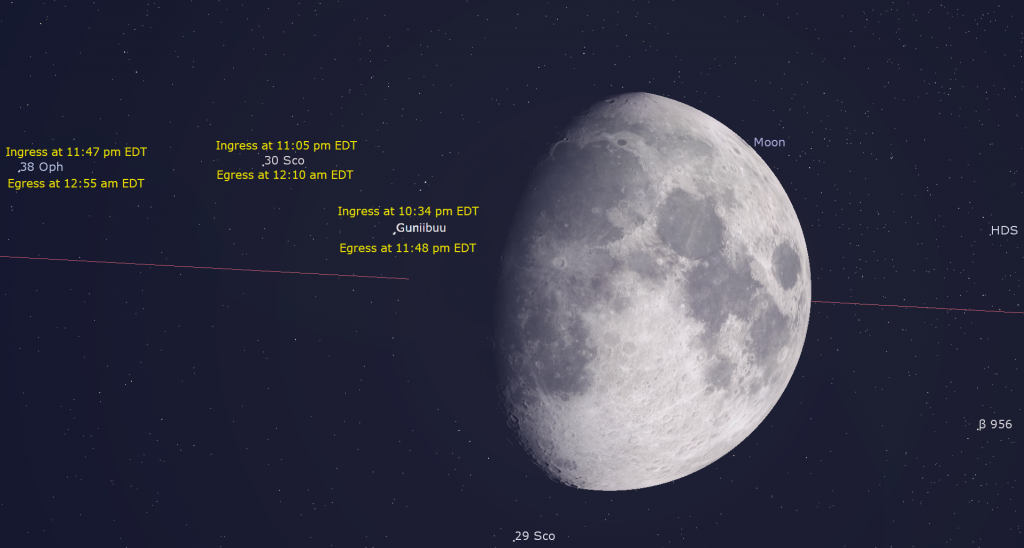
Also on Sunday night, the terminator on the waxing gibbous moon will fall just west of Sinus Iridum, the Bay of Rainbows. That semi-circular feature, 249 km in diameter, is a large impact crater that has been flooded by the same basalts that filled the much larger Mare Imbrium to its east – forming a rounded “handle” on the western edge of the mare. The “Golden Handle” effect is produced when low-angled sunlight brightens the prominent Montes Jura mountain range surrounding Sinus Iridum on the north and west. Sinus Iridum is almost craterless, but hosts a set of northeast-oriented wrinkle ridges that are revealed at this phase.
The Planets
All eight planets are visible from dusk to dawn nowadays. Evening planet-viewing begins right after sunset this week with the arrival of Mercury shining above the west-northwestern horizon – about a palm’s width to the left of where the sun sinks out of sight. Once the sun has completely disappeared, it’s safe to use binoculars for your search. The prime viewing window will fall around 9 pm local time, when Mercury will sit a slim palm’s width (5°) above the horizon. On each consecutive night, Mercury will shift to the left, farther from the sunset point. You’ll need a cloud-free horizon to see it.
Mercury will be around all month long, but it won’t climb very high for mid-northern latitude observers. Mercury’s show will be the best of the year if you live in the tropics or the Southern Hemisphere. On Wednesday, Mercury will shine telescope-close to Leo’s brightest star, Regulus. After the sun has completely set, use your optics to seek out the five times brighter planet positioned a finger’s width to the upper right (or 1 degree to the celestial north) of the star. Most telescopes will invert and/or mirror the view. On the following evening, Mercury’s orbital motion will shift it to a thumb’s width to the upper left of Regulus.

Saturn’s medium-bright, yellowish dot will already be shining above the southeastern horizon by 10 pm local time. It’ll have climbed high enough for reasonable telescope views by 10:30 pm, and those times will advance by half an hour with each passing week! We’ll be able to enjoy Saturn until early January.
This year Saturn is shining among the modest stars of eastern Capricornus (the Sea-Goat). Two little stars can be seen below Saturn. Those are Deneb Algedi on the left (east) and Nashira on the right (west). They represent the tail of the weird Sea-Goat, Capricornus. Since Saturn is now moving slowly westward in a retrograde loop that will last until late October, you can watch it shift more to the right (celestial west) above those stars over the next few weeks. Retrograde loops occur when Earth, on a faster orbit closer to the sun, passes the distant planets “on the inside track”, making them appear to move backwards across the stars. You can view the ringed planet all night long – but the clearest views will come during the wee hours, when it will be highest in the south, and seen through less of Earth’s distorting atmosphere. Any size of telescope will show you Saturn’s globe extending above and below its tilted rings, and a handful of its moons arrayed around the planet.
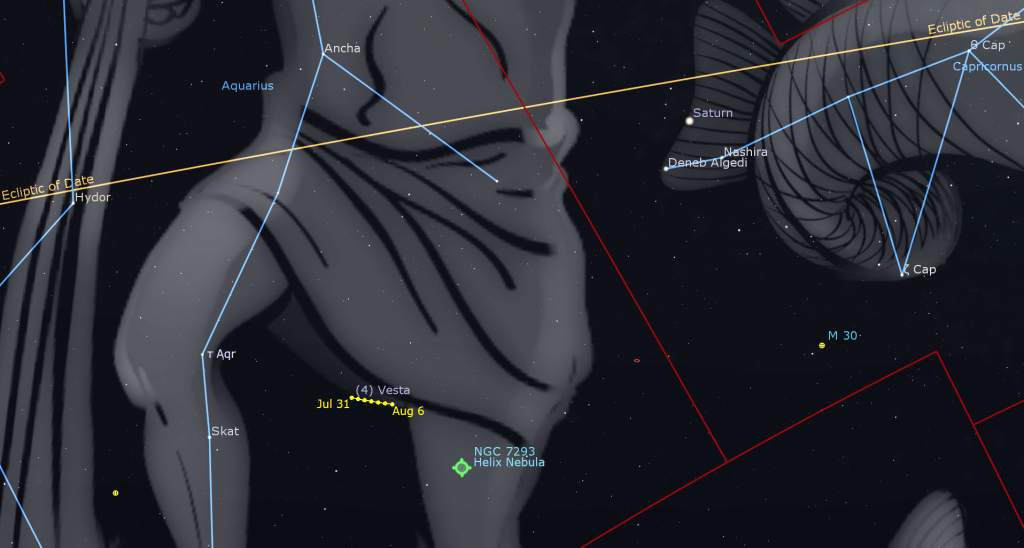
The main belt asteroid designated (4) Vesta is currently positioned 1.3 fist diameters to Saturn’s lower left (or 13° to its celestial east). Its fairly bright, magnitude 5.9 dot will be observable in binoculars and small telescopes, especially after midnight, when it climbs higher in the sky. For reference, look for Vesta several finger widths to the right (or 4.5 degrees to the celestial southwest) of the medium-bright stars Skat (aka Delta Aquarii) and Tau Aquarii. Telescope owners should note that Vesta is travelling just a few degrees to the upper left (or 3.5° to the celestial north) of the spectacular, but faint Helix Nebula, also known as NGC 7293. They’ll be closer in two weeks.
Extremely bright Jupiter will appear over the eastern horizon shortly after 11 pm local time, and spend the night following fainter Saturn across the sky. Jupiter will climb high enough to look good in a telescope from about 1 am local time onward. Early risers can spot the planet halfway up the southern sky Just before sunrise. Good binoculars will show Jupiter’s disk flanked by its row of four Galilean moons, which dance about the planet. You’ll see fewer than four if one or more is crossing in front of or behind Jupiter, or if they are occulting one another. Any size of telescope will show Jupiter’s dark bands running parallel its equator. For observers in the Americas, the Great Red Spot will cross Jupiter late on Monday, Wednesday, and Saturday night, and during the wee hours of Monday, Thursday, and Saturday morning. The small round, black shadow of Europa will cross Jupiter’s disk from late Friday night until 12:40 am EDT.

The faint blue speck of Neptune will be sharing the sky near Jupiter. The magnitude 7.8 planet will be positioned 1.3 fist diameters to Jupiter’s upper right, and a finger’s width to the upper right (or 1° to the celestial west) of a small star named 20 Piscium, which sits on the line joining Jupiter to Saturn. Neptune has a big moon named Triton that is visible in large aperture telescopes.
Medium-bright, reddish Mars will clear the eastern rooftops after about 1:30 am local time. The planet will brighten and grow larger gradually as Earth’s faster orbit draws us closer to Mars over the coming months. In a telescope, Mars will show a tiny, 85%-illuminated disk. From tonight (Sunday) to Tuesday, Mars will be passing less than a thumb’s width below (or 1.3° to the celestial south of) 170 times fainter Uranus. That’s close enough for the red and bluish planets to share the view in a backyard telescope! (Your telescope will likely invert and/or mirror their arrangement).
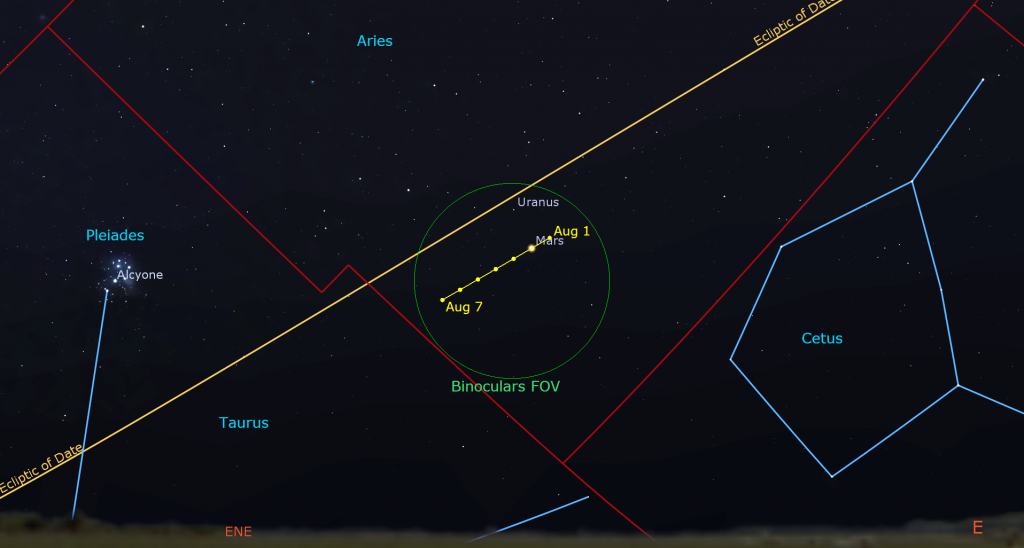
Magnitude 5.8 Uranus is easily visible in binoculars, which will also showcase the beautiful Pleiades star cluster twinkling a fist’s diameter to Uranus’s left. Mars will speed eastward away from Uranus on the following mornings, but they’ll continue to be binoculars-close for another week. When Mars isn’t near it, the brightest guidepost to Uranus is the medium-bright star named Botein (or Delta Arietis), which will appear several finger widths to Uranus’ left (or 3° to the celestial northeast). Uranus will be easiest to see when it’s higher in the sky, in the hours before dawn.
Extremely bright Venus will clear the east-northeastern treetops by 5 am local time every morning – but it won’t climb very high before sunrise – unless you live in the tropics. Venus will exhibit a waxing, nearly-round shape when viewed in a telescope or in good binoculars. The planet is slowly shifting closer to the sun.

Faint Comet Update
The moon won’t really interfere with views of comet C/2017 K2 (PanSTARRS) until after mid-week. Until then, the comet, which is still close to its peak brightness of about magnitude 8.5, remains within reach of backyard telescopes from dark locations. From now on, the comet will gradually fade in brightness as its climbs out of the plane of the solar system and heads increasingly farther from us and the sun. You can play with an online 3D model that nicely shows the comet’s orbit at https://theskylive.com/3dsolarsystem?obj=c2017k2
This week the comet will be observable from full darkness until after midnight. It will be moving below the stars of the Dalek-shaped constellation of Ophiuchus (the Serpent-Bearer), which sits in the lower half of the southwestern sky in late evening. During this week, the comet will be travelling downwards to the right (or celestial southwestward) between the bright stars Saik, which marks the mid-point of the bottom edge of Ophiuchus (the Serpent-Bearer), and Grafias.
Tonight (Sunday) Comet c/2017 K2 will be positioned two finger widths to the lower right (or 2.7° to the celestial west) of Saik. Next Sunday night, the comet will shift to sit several finger widths to Grafias’ left. Watch for the fuzzy patch of the globular star cluster known as Messier 107 sitting near the comet below Saik.
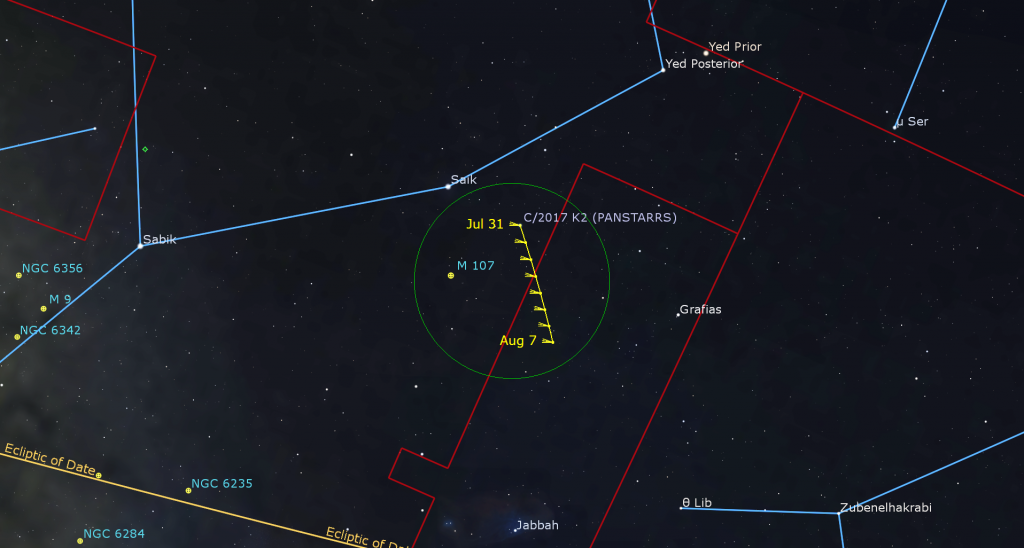
A Summer Triangle Tour
If you missed last week’s tour through the sky around the three bright and beautiful blue-white stars of the Summer Triangle asterism, I posted it here.
Public Astro-Themed Events
Every Monday evening, York University’s Allan I. Carswell Observatory runs an online star party – broadcasting views from four telescopes/cameras, answering viewer questions, and taking requests! Details are here. They host in-person viewing on the first clear Wednesday night each month. Other Wednesdays they stream views online via the observatory YouTube channel. Details are here.
Taking advantage of the crescent moon in the sky this week, the RASC Toronto Centre astronomers will hold their free monthly public City Sky Star Party in Bayview Village Park (steps from the Bayview subway station), starting between 8:30 to 9 pm on the first clear weeknight this week (Mon, Tue and Thu only). You don’t need to be an RASC member, or own any equipment, to join them – looks are free! Check here for details, and check the banner on their website home page or Facebook page for the GO or NO-GO decision around 5 pm each day.
On Wednesday evening, August 3 at 7:30 pm EDT, the RASC Toronto Centre will live stream their monthly Recreational Astronomy Night Meeting at https://www.youtube.com/rasctoronto/live. Talks include The Sky This Month, an astrophotographer’s tour of the Milky Way, and a talk about the James Webb Space telescope. Details are here.
On Thursday, August 4 at 8:30 pm EST, the Department of Astronomy & Astrophysics at the University of Toronto will stream their AstroTour. The live, free event will feature PhD Candidate Hannah Dykaar discussing Tidal Disruption Events: When a Black Hole Destroys a Star. Details and the YouTube link are here.
Eastern GTA sky watchers are invited to join the RASC Toronto Centre and Durham Skies for solar observing and stargazing at the edge of Lake Ontario in Millennium Square in Pickering on Friday evening, August 5, from 7 pm to 11 pm. Details are here. Before heading out, check the RASCTC home page for a Go/No-Go call – in case it’s too cloudy to observe.
RASC’s Public sessions at the David Dunlap Observatory may not be running at the moment, but they are pleased to offer some virtual experiences instead in partnership with Richmond Hill. The modest fee supports RASC’s education and public outreach efforts at DDO. Only one registration per household is required. Prior to the start of the program, registrants will be emailed the virtual program link.
On Saturday night, August 6 from 9 to 10:30 pm EDT, the DDO Astronomy Speakers Night program will feature Margaret Ikape, a PhD candidate in the department of Astronomy and Astrophysics, University of Toronto. She’ll speak on Probing the Epoch of Reionization with the Simons Observatory. There will also be a virtual tour of the DDO and live-streamed views from the DDO’s 74-Inch telescope (weather permitting). The deadline to register for this program is Wednesday August 3, 2022 at 3 pm. More information is here and the registration link is here.
On Sunday afternoon, August 7 from 12:30 to 1 pm EDT, tune in for DDO Sunday Sungazing. Safely observe the sun with RASC, from the comfort of your home! During these family-friendly sessions, a DDO Astronomer will answer your questions about our closest star: the sun! Learn how the sun works and how it affects our home planet. Live-streamed views of the sun through small telescopes will be included, weather permitting. Only one registration per household is required. Deadline to register for this program is Wednesday, August 3, 2022 at 3 pm. Prior to the start of the program, registrants will be emailed the virtual program links. More information is here and the registration link is here.
My free, family-friendly Insider’s Guide to the Galaxy webcasts with Samantha Jewett of RASC National returns on Tuesday, August 16 at 3:30 pm EDT, when we’ll do a summer planet preview! Plus, we’ll continue with our Messier Objects observing certificate program. You can find more details and the schedule of future sessions here.
Don’t forget to take advantage of the astronomy-themed YouTube videos posted by RASC Toronto Centre and RASC Canada.
Keep looking up, and enjoy the sky when you do. I love questions and requests. Send me some!
5 Responses
The two Toronto-area post-dusk ecliptic angles seem remarkably different for being only about a half-hour apart…. Just when I’d thought through the first one, understanding why it’s at such a shallow angle at dusk this time of year, suddenly it’s shown so much steeper a half hour earlier! Is there something about the view of 11-12 hrs sidereal time that makes it swing so rapidly down? (related to the geometry of the tilted ball that makes the rising and setting sun move so fast along the horizon during equinox seasons?)
Hi, Jim
The two views are from vastly different locations where Mercury is visible after sunset that day, namely Toronto (latitude 43 degrees N) and Georgetown, Guyana (latitude 7 degrees N). Changes in the tilt of the ecliptic, as viewed from a specified time and place, take weeks.
I meant the two labeled Toronto, the first on its own and the second alongside Guyana. I see now that the confusion is that the second one has the two panels labeled backwards? Caption looks correct but place labels on the image are reversed! (Steep ecliptic labeled Toronto, while the shallow ecliptic does match the earlier Toronto image)
Thank goodness it’s not that there’s a glitch in the eternal slow turning of the tilted earth as we gaze out at the gradually shifting perspective on the solar disc! Phew….
Thanks for catching the error in the annotations. Fixed now!